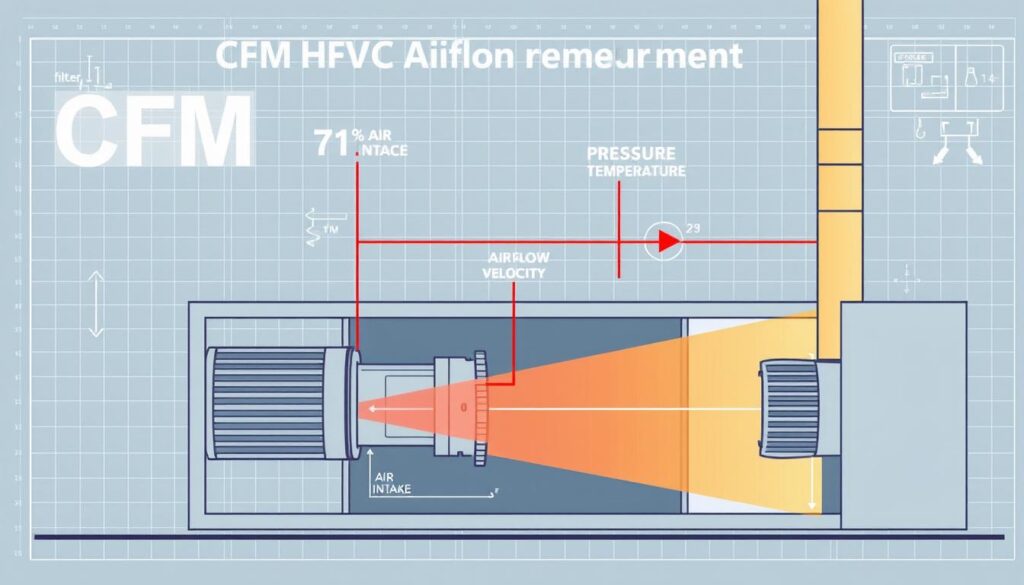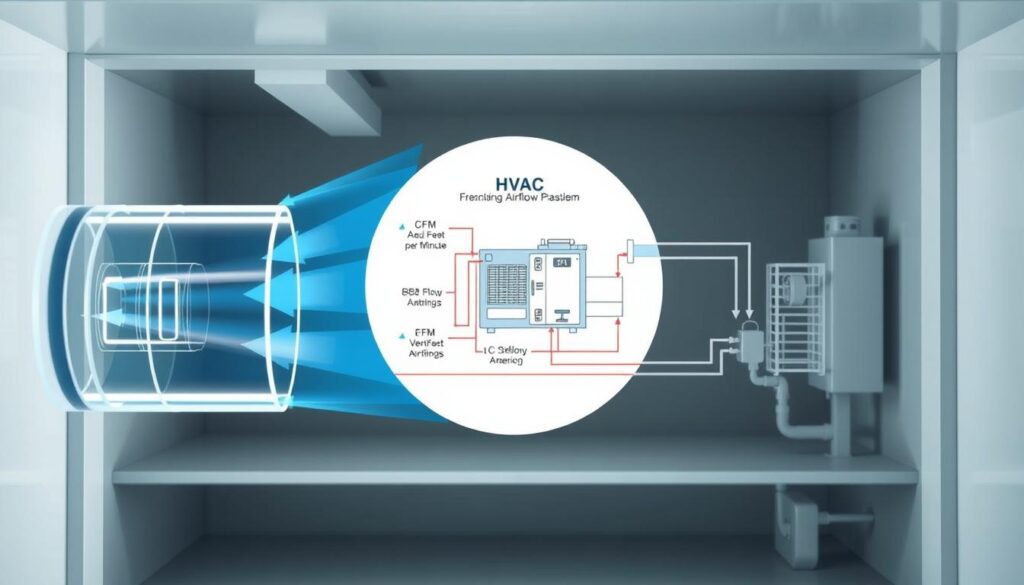Affiliate Disclosure
HVAC Guide Guys is a participant in the Amazon Services LLC Associates Program, an affiliate advertising program designed to provide a means for sites to earn advertising fees by advertising and linking to Amazon.
What is CFM HVAC? Ever wondered why some rooms feel stuffy while others are comfy? The answer is in understanding CFM HVAC. It changes how your home’s air feels and how comfortable it is.

CFM stands for Cubic Feet per Minute. It’s key in heating, ventilation, and air conditioning systems. This number shows how much air your HVAC system moves through your home’s ductwork each minute. It affects your comfort and how much energy you use.
Knowing about CFM helps you understand your HVAC system better. It’s not just about moving air. It’s about moving the right amount of air to keep your home cool in summer and warm in winter.
Key Takeaways
- CFM measures air volume movement in HVAC systems
- Proper airflow ensures optimal home comfort
- CFM impacts energy efficiency and indoor air quality
- Different spaces require unique CFM calculations
- Understanding CFM helps make informed HVAC decisions
Table of Contents
What is CFM HVAC: Basic Principles and Definitions
Knowing about hvac airflow measurement is key for keeping your space comfortable. Cubic feet per minute (CFM) shows how much air your HVAC system moves in one minute. It’s a vital number for checking how well your air conditioning works.
The Science Behind Cubic Feet per Minute
CFM tells you how fast air moves through your HVAC system. It’s calculated by measuring air volume at a specific point in your system.
- Measures air volume movement
- Determines system efficiency
- Crucial for understanding cfm in air conditioning
Role of CFM in HVAC Systems
Your HVAC system’s performance depends on good airflow. Each space needs a specific CFM rating. This depends on room size, ceiling height, and insulation.
| Space Type | Recommended CFM | Factors Influencing Airflow |
|---|---|---|
| Small Bedroom | 50-80 CFM | Room dimensions, occupancy |
| Large Living Room | 150-250 CFM | Ceiling height, window exposure |
| Commercial Office | 300-500 CFM | Occupant density, equipment heat |
Key Components of Airflow Measurement
To grasp cfm in air conditioning, you need to know a few key parts:
- Air registers
- Ductwork design
- Ventilation systems
- Pressure differential measurements
“Proper airflow measurement is the cornerstone of effective HVAC performance.” – HVAC Engineering Association
Explore Our HVAC Shop
Looking for top-rated HVAC tools, parts, and accessories? Visit our shop and find the perfect solution for your needs.
Visit the ShopThe Importance of Proper Airflow in HVAC Systems
Proper airflow in HVAC systems is key for good performance and comfort. Your HVAC system needs steady and balanced air flow to work right. This affects energy use and air quality inside.
Good airflow is important for several reasons:
- It helps keep temperatures even in different areas.
- It helps manage energy use.
- It makes your equipment last longer.
- It keeps the air inside clean.
“Proper airflow is the heartbeat of an efficient HVAC system” – HVAC Engineering Professionals
If your HVAC system doesn’t have good airflow, you might see uneven temperatures. You could also face higher energy bills and system failures. Bad airflow makes your system work too hard, which shortens its life and lowers its performance.
By improving hvac system airflow, you can:
- Use less energy.
- Feel more comfortable.
- Make your equipment last longer.
- Keep the air inside cleaner.
Experts say regular maintenance and airflow checks are vital. They help your HVAC system run at its best.
Types of CFM Measurements in HVAC Applications
It’s important to know about different CFM measurements for your HVAC system. These measurements help ensure good air flow and ventilation in your space.
There are several key types of CFM measurements for ventilation. Each plays a vital role in how well your system works:
Supply CFM: Delivering Comfort
Supply CFM shows how much air your HVAC system sends into a room. It affects how comfortable and cool or warm your space is.
- Measures air delivered into living spaces
- Indicates system’s cooling or heating capacity
- Critical for maintaining consistent room temperatures
Return CFM: Recycling Air Efficiently
Return CFM tracks the air pulled back into your HVAC system. This keeps air flowing and helps keep the air inside clean.
“Balanced airflow is the key to an efficient HVAC system” – HVAC Engineering Experts
Static Pressure and CFM Relationship
Static pressure affects your system’s CFM performance. High static pressure can limit air flow, making your system less efficient and using more energy.
Variable Air Volume Systems
Modern HVAC systems like Variable Air Volume (VAV) adjust air flow as needed. These systems make sure you get the right amount of air in each area.
- Adapts airflow to changing space conditions
- Improves energy efficiency
- Provides personalized comfort control
Explore Our HVAC Shop
Looking for top-rated HVAC tools, parts, and accessories? Visit our shop and find the perfect solution for your needs.
Visit the ShopCalculating CFM Requirements for Your Space
Knowing how to calculate air conditioning CFM is key for keeping your HVAC system running well. It’s important to figure out the right cubic feet per minute (CFM) for your space. This involves looking at several factors that affect comfort and system performance.

- Room square footage
- Ceiling height
- Desired air changes per hour
- Insulation quality
- Window placement and size
The basic formula for air conditioning CFM calculation is:
Room Area (sq. ft) × Ceiling Height (ft) × ACH ÷ 60 = Required CFM
Different areas need different CFM levels. For example, kitchens need more air flow because of heat from appliances. Homes usually need 0.5 to 1.0 air changes per hour. But, commercial places might need more air exchanges.
Experts say getting a detailed check is best to get the right CFM and HVAC efficiency. Things like local weather, building direction, and room use can change what CFM you need.
- Tip: Always consult with a professional for complex spaces
- Consider your specific environmental conditions
Getting CFM right helps your air conditioning work better. It cuts down on energy use and keeps your indoor air comfy.
CFM and HVAC System Sizing Guide
Choosing the right HVAC system means knowing how cfm rating affects performance and comfort. Your home’s unique features are key to finding the best hvac airflow measurement for heating and cooling.
When picking an HVAC system, consider several important factors. These factors impact your home’s comfort and energy use.
Room Size Considerations
The size of your space greatly influences cfm rating needs. Experts suggest:
- 20 CFM per 100 square feet for living areas
- 50-60 CFM per person in rooms with people
- Think about ceiling height and room layout
System Capacity Calculations
Figuring out the right HVAC system requires accurate airflow measurements. A central AC unit usually produces about 400 CFM per ton of cooling.
Pro Tip: A 1,200 CFM need usually means you need a 3-ton HVAC system for your space.
Zoning Requirements
Zoning lets you control airflow and temperature in different home areas. This method ensures:
- Better energy efficiency
- Custom comfort levels
- Less strain on your HVAC system
Getting the right cfm rating helps create a cozy, energy-saving home that meets your needs.
Common Airflow Problems and Solutions

Understanding cfm in air conditioning means knowing about airflow issues. These problems can affect how well your system works. Good airflow is key to keeping your home comfortable and energy-efficient.
There are a few common problems that can mess with your HVAC’s airflow:
- Clogged Air Filters: Dirty filters make it hard for air to move, so your system has to work harder.
- Leaking Ductwork: Air leaks out through gaps, making your system less efficient.
- Blocked or closed vents stop air from flowing smoothly.
- Broken blower fans can’t move air well.
Spotting airflow problems takes some attention. Signs like uneven room temperatures, higher energy bills, or strange noises mean your HVAC might have issues.
For small problems, quick fixes can help:
- Change air filters every 90 days.
- Check and seal ductwork joints.
- Make sure all vents are open and clear.
- Get your HVAC checked by a pro every year.
If simple fixes don’t work, a pro can do a deep check. They can fix your HVAC’s airflow problems for good.
Explore Our HVAC Shop
Looking for top-rated HVAC tools, parts, and accessories? Visit our shop and find the perfect solution for your needs.
Visit the ShopImpact of CFM on Energy Efficiency and Comfort
Your HVAC system’s performance is linked to its cubic feet per minute (CFM) airflow. Knowing how cfm and hvac efficiency work together can improve your home’s comfort and energy use.
Good hvac system airflow is key for steady indoor temperatures and less energy waste. When your system moves the right amount of air, it works better and uses less energy.
Energy Consumption Factors
CFM is important for your HVAC system’s energy use. Here are some key points:
- Balanced airflow reduces system strain
- Optimal CFM prevents short cycling
- Proper air distribution minimizes energy waste
Temperature Distribution Effects
Even airflow keeps your living space at a steady temperature. If CFM is off, you might have hot and cold spots. This makes your system work harder and lowers comfort.
| CFM Range | Comfort Level | Energy Efficiency |
|---|---|---|
| Low CFM | Inconsistent Temperatures | Poor |
| Optimal CFM | Balanced Comfort | High |
| High CFM | Potential Drafts | Moderate |
Indoor Air Quality Considerations
Your HVAC system’s CFM affects indoor air quality. Good airflow helps:
- Remove indoor pollutants
- Control humidity levels
- Circulate fresh air effectively
Getting a professional HVAC check can help you get the best CFM for efficiency and comfort.
Professional CFM Testing and Measurement Methods
Getting your hvac airflow measured right is all about the pro touch. It takes special skills and top-notch gear to get it right, more than just a quick home check.
- Duct Traverse Measurements
- Flow Hood Analysis
- Pressure Matching Techniques
- Digital Anemometer Readings
The key tools for detailed hvac airflow checks are:
- Anemometers – Track air speed and volume
- Digital Manometers – Spot pressure changes
- Thermal Anemometers – Follow air movement closely
Your HVAC system’s performance relies on correct cfm numbers. Pros look at many things during air conditioning cfm checks, like:
- How big your space is
- How high your ceiling is
- How many windows you have
- How your ducts are set up
- The local weather
Going pro for testing means better system performance, saving on energy, and a comfy indoor space. Home tests often miss the fine details that pros can spot.
Explore Our HVAC Shop
Looking for top-rated HVAC tools, parts, and accessories? Visit our shop and find the perfect solution for your needs.
Visit the ShopOptimizing Your HVAC System’s CFM Performance
To get the most out of your HVAC system, you need to focus on airflow. This means using techniques that boost your system’s efficiency. There are several ways to do this.
Start by looking at areas that affect airflow and efficiency:
- Regular air filter maintenance
- Ensuring unobstructed return air vents
- Keeping outdoor units clear of landscaping
- Implementing professional duct sealing
Changing your air filters is key to keeping your system running well. Dirty filters make your system work harder and use more energy. Change filters every 90 days or more often if you live in a dusty area.
There are advanced ways to make your HVAC system more efficient. Here are some:
- Install smart thermostats for better airflow control
- Try variable speed fan technologies
- Use zoning systems for personalized temperature settings
Good insulation and duct sealing help prevent air leaks. This makes your system work better. A well-kept HVAC system also saves energy and lasts longer.
“Consistent maintenance is the key to optimal HVAC system performance and efficiency.”
Conclusion
Knowing what CFM HVAC means is key for comfort and efficiency at home or work. This guide has covered the basics of cubic feet per minute (CFM) and its role in air conditioning. You now understand how to measure airflow, helping you make better choices for your HVAC.
CFM in air conditioning is more than just numbers. It’s about finding the right mix of air flow, temperature, and energy use. Your HVAC system’s airflow affects comfort, air quality, and your bills. Getting a professional to check and calculate CFM can boost your system’s performance and prevent problems.
As HVAC tech gets better, knowing about airflow becomes more vital. Whether you’re setting up a new system, upgrading, or keeping yours running, knowing CFM helps you make good decisions. Learning about your system’s airflow needs can lead to better comfort, less energy use, and a healthier space.
Starting your HVAC journey means understanding these basic ideas. By using what you’ve learned, you’ll become more knowledgeable about your air conditioning. This will help you keep your system running well for many years.

